2/27/2013
How PGRs Improve Water Use
Iftikhar Ahmad, Brian Whipker, John Dole & Ingram McCall
The effectiveness of plant growth regulators (PGRs) has been well documented. But growth retardants have a number of other advantageous effects on plants, including reducing water use, darkening of the foliage and improving postharvest performance. These secondary effects are being studied by North Carolina State University to determine their economic benefits for plant producers and shippers.
At the same time, efficient water use has become an important issue in many areas. Efficient water use will not only reduce production costs, but also increase profitability by reducing fertilizer runoff. It’s been documented that PGRs improve water use efficiency on some plant species; however, very little information is available about ornamental plants. Moreover, this study was conducted to optimize the PGR rate for selected ornamental species.
Two potted bedding plants—Pacino Gold sunflower and Magellan Pink zinnia—and four plug crops—Moonsong Deep Orange marigold and Magellan Pink zinnia, grown from seed—and Fiesta Burgundy impatiens and Suncatcher Coral Prism petunia, grown from vegetative cuttings—were used in this study. For all species, plants were grown in either 36-cell (for potted plants) or 128-cell (for plug studies) trays using Fafard 1P substrate. Potted plants were transplanted into either 6-in. (sunflower) or 4.5-in. pots (zinnia) at 2-true leaf stage.
For two weeks after transplanting, plants were sub-irrigated as needed. Then 48 hours before the PGR applications were made, the plants were irrigated to field capacity (FC) and allowed to drain. Two days later the plants were drenched with 4 oz. of paclobutrazol at 0, 1.0, 2.0 and 4.0 mg of active ingredient (a.i.) for sunflower, and 2 oz. of 0, 0.5, 1.0 and 2.0 mg for zinnia. For plugs, when plants reached the 2-leaf stage, trays were sub-irrigated to FC, drained for 30 minutes and sprayed with ancymidol at 0, 40, 80 and 160 ppm.
After the PGR application, further irrigations were made when the fresh weight was less than 40% of available water, which was the difference in weight of the container, substrate and plant between field capacity and the permanent wilting point. Plants were weighed twice a day for plug studies and daily for potted plants; those requiring irrigation were sub-irrigated for five minutes with a calculated water amount followed by draining them on top of the saucer for 30 minutes and water use was recorded as the difference between the amount of water supplied and the amount of water that drained. All plants were maintained in a polyhouse and irrigated with water supplied with 150 ppm nitrogen of a 20-10-20 fertilizer. Data was collected on daily water use, total water use, termination fresh weight, termination dry weight, leaf relative water contents and water use efficiency. Plant height and plant diameter was also measured at termination for potted plants.
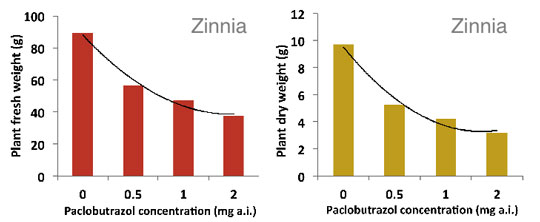
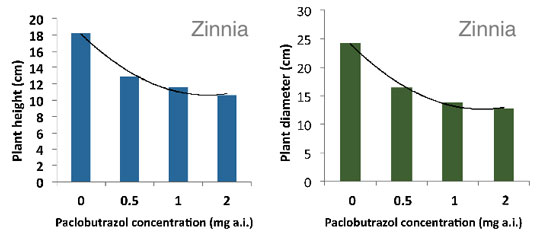
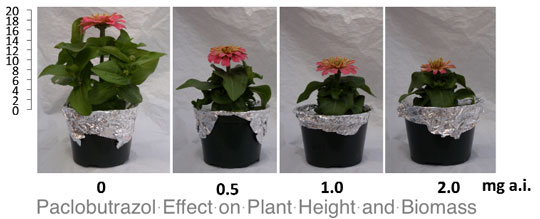
Results
As the PGR concentration increased, plant growth (fresh weight, dry weight, plant height and diameter) and total water use was less for all species. For the potted sunflower, the optimal concentration of paclobutrazol for growth control was between 1.0 to 2.0 mg a.i., which resulted in 24% less water usage at 1.0 mg and 31.5% less water used at 2 mg, as compared to the control. For potted zinnia, optimal paclobutrazol drench concentration was between 0.5 to 1.0 mg a.i., which corresponded to 33 and 45% less water being used as compared to control (Figure 1). For plugs, the optimal concentration of ancymidol was a foliar application of 80 to 160 ppm, as these concentrations reduced water use by 6 to 15% for impatiens, 1 to 7% for marigold, 17 to 25% for petunia and 10 to 18% for zinnia.

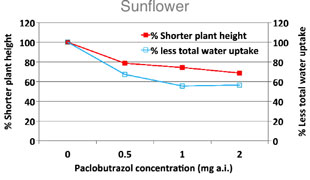
The reduction in water use due to PGR applications was proportionally similar to the reduction in plant size for zinnia, but greater with potted sunflower (Figures 2 and 3). This indicates for sunflowers that the PGR not only reduced water use by making the plant area smaller, but also allowed water to be used more efficiently by the plant. Similarly, PGRs had a greater effect on water use of impatiens plugs than on plant size (Figure 4). Generally, however, it appears that when optimal PGR rates are used, the savings in water use will be proportional to the reduction in plant size.
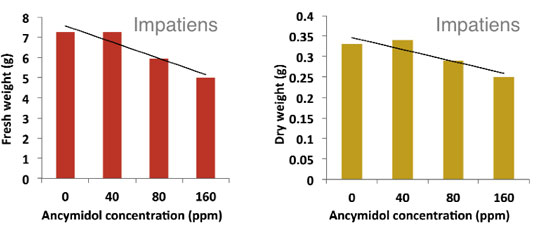

Conclusions
Application of plant growth regulators not only controls excessive plant growth, but also reduces water use. Producers should consider the water-use reduction from using PGRs in addition to the traditional benefit of growth control as a best management practice.
GT
We’d like to thank the USDA for providing the funding for this research and Ball FloraPlant for providing cuttings.
Brian Whipker and John Dole are Professors of Horticulture, Iftikhar Ahmad is a Postdoc Fellow, and Ingram McCall is a Floriculture Technician in the Department of Horticultural Science for North Carolina State University in Raleigh, North Carolina.